| About Neoclassicism | ||
| Roots of Neoclassicism | ||
| Neoclassical Style in the Arts | ||
| Quotations |
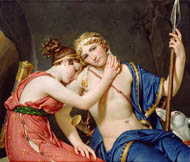 |
||
About Neoclassicism
Beginning in the 1750s, new theories and practices in art and design were driven by a deliberate aim to replace what many saw as the frivolity and superficiality of the Rococo style. Prominent during the first half of the 18th century, this style was characterized by artifice, asymmetry, luminous colors, motifs derived from natural forms, and, sometimes, playful subject matter. Neoclassicism, the so-called "true style," came from a desire to imbue the visual arts with greater seriousness and moral commitment.
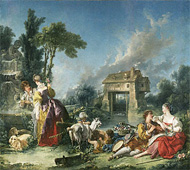 |
||
Theorists such as German art historian and archaeologist J. J. Winckelmann (1717–1768) and artists such as Giovanni Battista Piranesi (1720–1778) emphasized the reforming power of the arts of ancient Greece and Rome and held them up as the model for contemporary artists. These men believed that ancient art embodied qualities of purity, truth, and stoicism that were lacking in the work of Rococo artists such as François Boucher (1703–1770). Denis Diderot (1713–1784) believed that the Rococo was morally flawed and artistically inconsequential. The antidote to the Rococo was, in his mind, a moralizing interpretation of narrative history and genre art. Diderot's critiques of the annual Salons in Paris, read by Europe's elite, praised the moral values of paintings by Jean-Baptiste Greuze (1725–1805) and the restrained still-life paintings of Jean-Siméon Chardin (1699–1779).
Neoclassical artists and critics sought to revive the ideal of classical Greece and Rome in architecture, sculpture, painting, and the decorative arts. This ideal was seen by early proponents of the style, like Winckelmann, to be grandeur informed by simplicity of shape and exactness of proportion rather than by elaborate decoration and ostentatious materials. Neoclassicists sought subjects that best served as moral exemplars. While the earlier, Rococo artists had often depicted the loves, flirtations, and debaucheries of the gods when treating ancient subjects, the artists of this "true style" focused on accounts of filial or national devotion, fidelity, and courage.
Neoclassicism became the style of the Enlightenment, the dominant intellectual trend of thought in Western Europe and America in the 1700s. It was preferred by American and French revolutionary thinkers such as philosophes, Jacobins, and the U.S. founding fathers, who saw in it an impulse to purge visual culture of the evils of excess, artifice, and tyranny. However, the Neoclassical style was also adapted to represent the interests of those who tried to repress the very freedoms advocated by the thinkers of the Enlightenment and the revolutionaries. Neoclassicism became the court style of Louis XVI of France, Catherine II of Russia (czarina of Russia 1762–1796), and, eventually, of Napoleon. Whether used by revolutionaries or despots, Neoclassical arts were characterized by a sense of order, logic, and clarity. In subject matter and content, concepts such as duty to a higher cause (one's country or its ruler) as well as a sense of decorum, appropriateness, and morality were emphasized.
Roots of Neoclassicism
Greco-Roman Art and Philosophy
The quest for a timeless mode of expression (the so-called "true style") involved divergent approaches toward design that were focused on the Greco-Roman debate. While little was known of Greek, as opposed to Roman, art during the early years of Neoclassicism, advances in the study of the history and archeology of antiquity led to an appreciation of these distinct ancient cultures. Aesthetics developed as a discipline in order to assess the relative values of art from Greece and Rome. On the one hand, there was a commitment to a severity of expression, associated with the Platonic Ideal (based on the teachings of the ancient Greek philosopher Plato), as well as to such criteria as the functional and the primitive, which were identified particularly with early Greek art and architecture. On the other hand, there were highly innovative exercises in eclecticism, inspired by the ancient art of the Roman Republic and Imperial Rome (6th century B.C.–5th century A.D.).
The writings of the art historian J. J. Winckelmann (Reflections on the Imitation of Greek Art in Paintings and Sculpture, 1755) on the side of Greek art and civilization, and those of the draftsman and writer Giovanni Battista Piranesi on behalf of Roman ornament and engineering (Le Antichita Romane (Viewpoint on Architecture), 1756), represented two sides in an ongoing debate over the moral superiority of the two ancient cultures. These fresh interpretations of classical art evoked, in the work of some artists, powerful emotional responses to the past. This requires Neoclassicism to be understood as closely related to the movement of Romanticism, rather than an opposing movement.
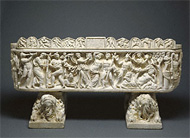 |
||
Archeology and the Rise of Historicism
The burst of archeological activity in the 18th century led to new insights into ancient history. The range of these discoveries extended from Italy to the eastern Mediterranean, Egypt, and the Near East. Among the important excavations were those starting in 1738 and 1748 respectively at Herculaneum and Pompeii, both cities destroyed by the eruption of Mount Vesuvius in A.D. 79. These discoveries stimulated an emergence of new historical attitudes toward the past—toward the non-classical as well as the classical. The new awareness of the plurality of historical styles prompted a conscious search for new contemporary forms of expression.
Enlightenment
Though not a single unified movement, the Enlightenment was founded on a belief in progress and the power of reason. Recent achievements in science encouraged the belief that social, intellectual, and moral reforms could be effected through the acquisition of knowledge and the application of reason. The Enlightenment's intellectual leaders included philosophers and writers such as Voltaire (1694–1778), Denis Diderot, and Jean-Jacques Rousseau (1712–1778) in France; David Hume (1711–1776) in Britain; Immanuel Kant (1724–1804) and Gotthold Ephraim Lessing (1729–1781) in Germany; and Thomas Jefferson (1743–1826) and Benjamin Franklin (1706–1790) in America. Their differing temperaments and the varied contexts in which they lived led to varying expressions of the same basic premise.
Some foundations of the Enlightenment had developed in 17th-century England. In his Essay Concerning Human Understanding (1690), the philosopher John Locke (1632–1704) asserted that there are no innate ideas. This concept formed the basis of empiricism—the practice of relying on observation and experiment, especially in the natural sciences—and led to the conclusion that humans are the product of their environment. The workings of that environment were thought to have been uncovered in the universal, mechanistic theories of Sir Isaac Newton (1643–1727) in his Philosophiae naturalis principia mathematica of 1687. These two developments prompted the notion that laws could be found that governed not only nature but also man and society. Furthermore, the continued success of science in this period led to a widespread belief that through a reliance on reason, progress in general was possible.
Thus, Enlightenment theorists vigorously attacked whatever seemed to them to be outmoded, irrational, or empirically unjustified, as shown by Voltaire's polemics against prejudice, superstition, and the perceived excesses of the Roman Catholic Church. The methodology of reason was used to accumulate and codify knowledge, leading most importantly to the monumental Encyclopédie (Encyclopedia, 1751–1765), edited by Diderot and Jean Le Rond d'Alembert (1717–1783), a 28-volume compilation of articles on contemporary thought and beliefs, the arts, science, and crafts.
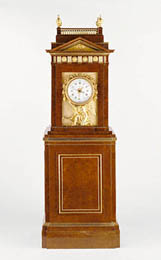 |
||
The impact of the Enlightenment on the arts took various forms. Some artists, such as Joseph Wright of Derby (1734–1797) paid homage to science, as in his paintings of scientific experiments and portraits of leading scientists. In the decorative arts, the scientific instruments of enlightenment became art objects. Barometers, planispheres, and most notably, clocks were embellished and designed to be marvelous treasures—a reflection of the esteem in which their functions were held. To artists like the French sculptor Jean-Antoine Houdon (1741–1828), the concept of truth in art meant close observation of the physical characteristics of a sitter in order to convey his or her humanity and individuality. The still-life painter Jean-Siméon Chardin created stripped-down compositions that caused Diderot to write in 1767, "Oh, Chardin...you sweat blood and tears, you study nature,...you produce sublime poems with your brushes...."
The more characteristic Enlightenment images are, however, those of classical antiquity, which relate the movement to Neoclassicism. The perceived nature of classical art—its realism, restraint, harmony, and order—was in tune with Enlightenment ideology. The cultures of ancient Greece and Rome embodied ideals to which the advancement of humankind could be directed and also provided historical proof of their achievability. Furthermore, the fact that these cultures were pagan appealed to the antireligious tendencies of some Enlightenment theorists. By using both the style and subject matter of classical art, contemporary artists believed the "true style" to be a means of morally improving the viewer, therefore giving art a socially beneficial role.
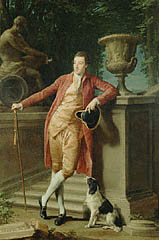 |
||
Rome and the Grand Tour
Rome was the center of art production in Europe and an important breeding ground for Neoclassicism. Artists as geographically diverse as the Italian sculptor Antonio Canova (1757–1822); the painter and president of the British Royal Academy, Joshua Reynolds (1723–1792); the French painter Jacques-Louis David (1748–1825); and the American portraitist and history painter John Singleton Copley (1738–1815) worked in this city and then left to spread Neoclassical ideas abroad. Piranesi and Winckelmann, proponents of the movement, also lived and worked in Rome.
Rome was equally important as a destination on the Grand Tour, a rite of passage for the young men and women of noble and important families in Europe and the United States who would spend one to eight years finishing their education in Rome, the "Eternal City." A crossroads for the future tastemakers and leaders of Europe and America, Rome was the place where residing artists and writers imparted an appreciation for the Neoclassical style, which visitors would carry back with them at the end of the tour.
Rise of Art Academies, Public Museums, and Galleries
The very nature of the Enlightenment and the objective of Diderot's and d'Alembert's Encyclopédie was to promote inquiry into the broadest range of activities. The arts were seen to have an important responsibility for spreading knowledge as well as serving the interests of the state. Consequently, numerous art academies were established during the later 18th century by various governments in Europe to improve the intellectual training of artists and architects and to ensure that the objectives of these "academics" were aligned with those of the state. Accompanying this concern with education was the rise of professional organizations for artists and architects (often providing qualifications and diplomas) to enhance their social status, as exemplified in Joshua Reynolds's program for the Royal Academy in London (established 1768). Within this institution, the status of women artists began to be recognized, with the inclusion of the history and portrait painter Angelica Kauffman (1741–1807) and the flower painter Mary Moser (1744–1819) among the 40 founder-academicians.
In response to the didactic role of art as a moral and intellectual force in society, public museums and art galleries were also established with educationally motivated programs of display. In 1753 the British government founded the British Museum in London from the private collection of the physician and scientist Sir Hans Sloane, and in 1793 the Central Art Museum in the Palais du Louvre in Paris was designated a public museum. In the last quarter of the 18th century, the Vatican's unrivalled collection of antiquities was arranged in a sequence of sophisticated displays. In the early 19th century several important new museums and galleries were constructed in Europe.
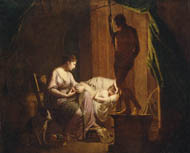 |
||
Neoclassical Style in the Arts
Painting
By the mid-1750s the Scottish artist Gavin Hamilton (1723–1798) was pioneering in Rome a new type of history painting that featured morally uplifting themes from antiquity. The English painter Joseph Wright of Derby was influenced by this type of moralizing subject matter and followed suit in paintings like Penelope Unraveling Her Web (1783–1784), a variation on the popular Neoclassical theme of the grieving widow. This theme, and the equally popular theme of sacrifice for the state, were perfected by perhaps the greatest painter in this style, Jacques-Louis David, with such heroic pieces as Andromache Mourning Hector (1783) and The Oath of the Horatii (1784). These drew, thematically as well as formally, on ancient sources and echoed David's later active involvement in revolutionary politics.
The Neoclassical style was not limited to history painting. Greek and Roman ruins became the subject of landscape painters like Canaletto (1697–1768), while in genre painting, Jean-Baptiste Greuze ennobled scenes of middle-class life using the heroic poses of the antique.
Architecture
In England, early 18th-century architects like William Kent (1674–1748) had anticipated continental Neoclassicism by several decades with Palladianism. Palladianists followed the Venetian architect Andrea Palladio (1508–1580) and created architecture and interiors based on direct archeological sources from antiquity. Kent was among the first designers in England to reintroduce the antique style of grotesque painting, in imitation of decorations found in the excavated residence of the emperor Nero.
Under Neoclassicism, the search for "true style"—one that would be unique to the late 18th century and responsive to fresh social needs—took a variety of forms. The semicircular plans and tiered seating of Greek theaters and Roman curiae (buildings used for senate assembly and meeting in ancient Rome) were adapted for political assemblies, passing later into building patterns for legislative halls, such as British architect Benjamin Henry Latrobe's House of Representatives (1803–1807) for the U.S. Capitol in Washington, D.C. Motifs drawn from Etruscan and Imperial Roman sources were advocated by Piranesi in his treatise Viewpoint on Architecture (1765), in which he defended eclecticism. This broadly based system of composition found its most accomplished and original application in the architecture and furniture designs of Robert Adam (1728–1792), while Thomas Jefferson turned to a celebrated Roman exemplar, the Square House, a well-preserved ancient temple in Nîmes, France, for the basic form of his State Capitol (1785–1799) in Richmond, Virginia. In all these works, classic order was seen as expressive of civic and national virtues.
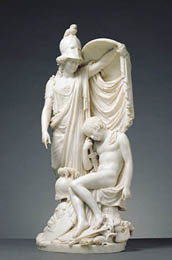 |
||
Sculpture
Contemporary sculpture, following Winckelmann's precepts of "noble simplicity and calm grandeur," also showed a new seriousness of purpose, as well as formal restraint. In narrative works, subjects of extreme emotion, which were the choice of earlier sculptors, were avoided in favor of episodes of calm, or post-victory triumph. In their portraits, sculptors such as Joseph Chinard (1756–1813) and Francis Harwood (active 1748–1783) attempted to reconcile likeness and psychological character with the timeless properties of the ideal, as derived from classical prototypes.
White marble, which evoked ancient sculpture, became the preferred material of the Neoclassical sculptor. In the 18th century there was a widely held, though erroneous, belief that the ancients preferred this aesthetically pure material for their sculptural works. In fact, classical marble sculpture was typically covered in brightly hued paint, which, due to weathering, had largely disappeared from the excavated works. Bronze was also often used for large-scale classical sculpture. While several examples of classical bronze sculpture were known at the time, the great majority of ancient works in this medium had been melted down for more practical applications after the fall of Rome. Therefore, the sculptures entering the great collections of Europe were, for the most part, marble.
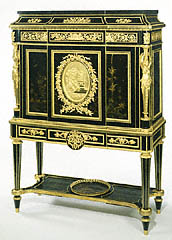 |
||
Decorative Arts
In the applied and decorative arts, theorists such as Charles-Nicolas Cochin the Younger (1715–1790) advocated an emphasis on austerity and geometric restraint, a sharp reaction against the curvilinear and sensuous forms of Rococo designers. In France this launched a fashion for the rectilinear, chunky classical details of the so-called Goût Grec, meaning "Greek Taste," a new style that was refined by such outstanding ébénistes of the Louis XVI era as Jean-Henri Riesener (1734–1806) and David Roentgen (1743–1807).
In Their Own Words:
Quotations related to Neoclassicism and the Enlightenment
"For we are lovers of the beautiful, yet with simplicity, and we cultivate the mind without loss of manliness. We are the school of Greece." — Pericles
"The artist must be a philosopher and have no other guide except the torch of reason." — J.-L. David
"The most ancient records...teach us that the earliest [attempts]...in the drawing of figures have represented not the manner in which a man appears to us, but what he is; not a view of his body, but the outline of his shadow. From this simplicity of shape the artist next proceeded to examine proportions; this enquiry taught exactness; the exactness hereby acquired gave confidence, and afterwards success, to his endeavors after grandeur, and at last gradually raised art among the Greeks to the highest beauty." — J. J. Winckelmann
"There is but one way for the moderns to become great, and perhaps unequalled; I mean by imitating the ancient...especially the Greek arts." — J. J. Winckelmann
"Must the genius of our artists be so basely enslaved to the Grecian manners, as not to dare to take what is beautiful from elsewhere, if it be not of Grecian origin? But let us at last shake off this shameful yoke, and if the Egyptians and Etruscans present to us in their monuments, beauty, grace and elegance, let us borrow from their stock." — G. B. Piranesi
"The function of art is to make virtue adorable and vice repugnant." — D. Diderot
"Art must have grandeur and moral purpose." — J.-L. David
"Poetry fettered fetters the human race. Nations are destroyed, or flourish, in proportion as their poetry, painting, and music are destroyed or flourish!" — W. Blake
"The man who occupies himself solely in the study of antiquities and the fine arts...should live in Rome. The very stone that he treads on will speak to him; the dust blown by in the wind around him will be decomposed particles of some great human being." — F. R. de Chateaubriand
"Bad buildings, which have been planned or constructed without order or intelligence or which are overladen with foolish, grotesque, or exuberant decoration necessarily have a bad effect on the mentality of the people." — J. G. Sulzer
"Classical art is part of nature and, indeed, when it moves us, of [noble] nature." — J. W. von Goethe